by Wine Owners
Posted on 2021-06-30
As mentioned in our recent and well received offer of the incredibly well priced Montepeloso Eneo 2010 (there are a few left), we promised a closer look into the relative value of Italian wines. I know I have been banging on about Italy for quite a while now but there is every reason for it – there is some terrific value to be had, and so on will I bang!
The facts are that there are only a handful of Italian wines that trade at, what we are going to call here, ‘silly money’ compared to vast swathes of wines from their rather posher neighbour - namely La Belle France. It is true that the same can be said for Spain, and for most of the New World. The U.S. is an exception, as like France, it has many an offering at ‘silly money’. But for my pound, I say sweepingly, these regions do not offer such a vast variety of quality wines that appeal in quite the same way (I should qualify at this point I am really talking about top quality red wines).
What Italy offers, unlike everywhere else, is a multitude of wines at relatively affordable prices with absolutely massive ratings. There are two variables here, the prices and the ratings; the simplest explanation for the comparatively lower pricing is that Italian wines have not yet been recognised, and accordingly priced, as truly international brands. Put another way, Asia has not got to grips with it yet. Other than a few ‘Super Tuscans’ and the top labels from the likes of Giacomo Conterno, Bruno Giacosa and Gaja from Piedmont, very little starts life close to £100 a bottle. There have been half a dozen EP releases every day last week from Bordeaux that qualify for that prize! In Burgundy a hefty percentage of premier crus start there and for some more sought-after growers, your £100 only buys you a taste of a lowly village wine.
The ratings are, rather obviously, dished out by the critics. It is worth remembering that each region is scored on its merits in a peer group fashion. The wines, as are the vintages, are reviewed in the context of that individual region or vintage. What has happened, however, is that tones have been set for different areas which do seem to vary from each other. Burgundy, for example, tends to harbour rather conservative scoring where anything over 95 is a massive achievement. Prices for these trophies are also massive. It is different in Italy. There are countless Brunelli with huge scores and even people in the trade ask, ‘how come there are so many 100 pointers we’ve never heard of’?
A possible explanation is that the bar has been set so high, and for so long, by the likes of DRC and Rousseau that a mere premier cru from someone like Dujac or Roumier is only worthy of 90/91 points. So, perhaps a cleaner canvas for the critics to assess has led to some more generous brushstrokes? Or perhaps it is a more generational thing; France has long been understood, consumed, and pontificated upon by the old guard, who might not quite understand the Italian way? An old friend of mine, an experienced wine merchant recently said to me “I don’t really get Italian wine” (Burgundy and Sauternes are more his bag!) and then confused me further by saying “except I couldn’t possibly eat Italian food without Italian wine”. I understand exactly what he means with the latter statement (but not the first), and this goes from pizza level all the way to Piazza Duomo, a three star Michelin in Alba – quite good by the way! Either way, some of the scores in recent times and particularly for the amazing ’16 vintage, in all of Italy, and the ’15 vintage in Tuscany, have drawn truly flamboyant landscapes from the young masters – and for not many Lira either!
The other thing to remember is that the critics live and die by their reputations, so if they are going to award high nineties or even the magical triple digits, you know the wines are going to be very good indeed – within the context of their peer group.
Obviously, we would love to hear from you to discuss the opportunities further and there will be offers to follow based on this theme. In the meantime, you may want to engage with the ‘Advanced Search’ button or take in some of these names which spring to mind:
Piedmont: Alessandria, Cavallotto, Grasso, Sandrone, Scavino, Vajra
Tuscany: Fontodi, Fuligni, Grattamacco, Il Poggione, Isole e Olena, Pertimali, Montepeloso
Ciao for now! Miles 07798 732 543
by Wine Owners
Posted on 2019-04-16
Italia! From the the country that has given us espresso and cappuccino, ciabatta and focaccia, minestrone and spaghetti, Maldini and Rossi, Pavarotti and Verdi, Canaletto and Leonardo da Vinci, Ferraris and Maseratis, Bunga Bunga, the Mafia and the Pope, we now have… un'opportunità di investimento – nel mondo del vino!!
The Italians are not only the largest wine producing country in the world, they have been making wine for over four thousand years and cultivate over two thousand grape varieties on a multitude of different soils in twenty different regions! They are not bad at food either. Their climate seems to suit most of the finer things in life.
Italian wine being recommended is nothing new, but having it recommended as a collectable asset bearing an investment case is another matter. Ten years or so ago, a few canny collectors realised some of the ‘Super Tuscans’ (red wines typically made of a Bordeaux blend in Tuscany) such as Masseto, Ornellaia, Sassicaia (see recent blog post) and Solaia were ripe for decent returns. Traditionalists were a bit put out by these glossy new pretenders turning up on the Italian wine scene with their fancy French grape varieties and lots of marketing but it is fair to say they have helped the overall attention given to Italy and, as a result, the ‘Bs’ are blossoming – namely, Barolo, Barbaresco and, to a lesser extent, Brunello.
Wines from the best producers of Italy’s most venerable regions have been collected by the cognoscenti for years but now their appeal is becoming more widespread. The problems of Bordeaux, following an explosive China-driven period, have been well documented in the last decade and although we are quietly confident on a comeback from the sleeping giant, the smaller top-quality regions have been profiting. The indices for cult Californian (+98%) and beautiful Burgundy (+135%) have both gone berserk in the last five years, whilst Piedmont has gained a more modest 78%, with Tuscany posting +50%.
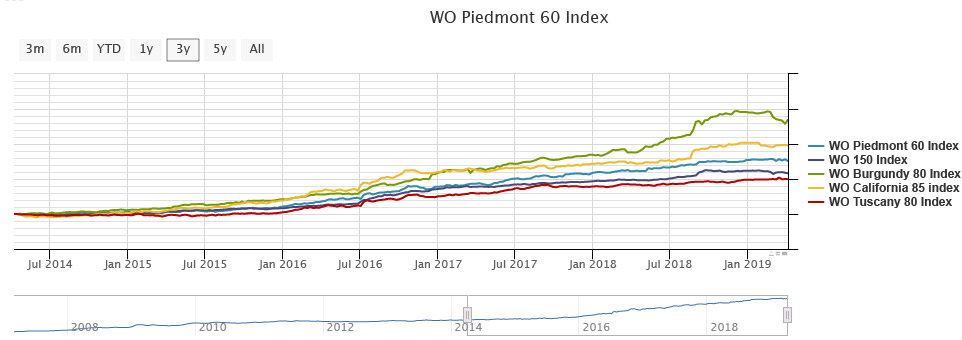
The reason for Burgundy and California’s performance is that old tried and tested wine world fundamental of demand outstripping supply - who knew!?? Both these regions produce tiny quantities in comparison to the number of people looking to access these markets and gain exposure. The complex nature of these regions with tiny vineyards, often co-owned by different families and winemakers, has added to the gloss and mystery, spurring on newcomers to learn more and invest time and money accordingly. More of the written word is more easily accessible to interested folk, and with platforms such as Wine Owners to trade on, the visibility of the product and the liquidity of the commodity has increased.
Grand Nebbiolo from Piedmont is yet to hit the big time, apart from a few, but there are more than rumblings in other names; dedicated collectors and the inquisitive are homing in. It is a Burgundian-like network of vineyards, producers, families and reputations and you need to know what you are doing. Famous names like Conterno, for example, have six listings in my favourite reference book: Aldo, Diego, Fantino, Franco, Giacomo (the big one) and Paolo.
Some of the bigger names like Giacomo Conterno famed for his Montfortino vineyard, Giuseppe Rinaldi, famed for Brunate and Tre Tine, Bartolo Mascarello and Gaja are already highly sought after superstars with prices to match but there are a host of others with reputations and demand beginning to swell; Brovia, Cappellano, Fratelli Alessandria, Sandrone, Voerzio and Vietti to name a few.
The ‘Super Tuscans’ of Bolgheri are much simpler to understand, like Bordeaux versus Burgundy, and are produced in larger numbers. The names mentioned earlier are virtually household names (in wine terms!) and are less exciting right now overall. Brunello di Montalcino, made from Sangiovese, is also comparatively easy to piece together in relation to Piedmont. Biondi Santi, Poggio di Sotto, Salvioni and Soldera are the big names with the fancy price tags. The secondary market for Brunello has not yet developed so, for now at least, it is a case of keeping a watchful eye.
There have been some excellent vintages in the last decade or so, attracting fantastic media coverage and battle-weary Bordeaux buyers. Another reason for favouring Italian wines in the current climate is that the U.S. and Germany are the biggest export markets, so unlikely to be affected by any potential fallout from Brexit. Most of all, however, these wines are barely scratching the Asian surface as yet and we all know what happens when that changes!
by Wine Owners
Posted on 2019-03-14
2007 £1,300 per 6 WO Score 96
2010 £2,100 per 6 WO Score 100
Bartolo Mascarello is one of the true legends of Barolo, think Rousseau or Roumier in Burgundy terms, in case you’re not familiar with the ‘Knights of Nebbiolo’. And if that’s still confusing, think Liverpool (Football Club), but I would say that, wouldn’t I? In fact, to be drawn against Juve tomorrow morning could easily inspire a trip to Piedmont, with a bit more than hazelnuts to look forward to! I digress…
Maria-Teresa Mascarello took over from Bartolo, her father, in 1993, the estate having been founded in 1918. Beautifully simple in its creation, the wine is a blend of four of the top crus, or vineyards and has been consistently and spectacularly successful for decades.
In the charts above and below we have compared various well-regarded vintages of a similar era. These vintages are very good and very scarce, two of the most important factors for investors as they are squirreled away by the canniest collectors and prices have been rising. They are still a fraction of their Burgundian cousins however and we have no issue with recommending a buy, particularly the ’07 and the ’10, the cheapest relative value bets here:
Tasting notes, courtesy of Vinous Media:
2007: Mascarello’s 2007 Barolo shows just how compelling this vintage can be, even now. Sensual, layered and totally voluptuous in the glass, the 2007 shows the more flamboyant side of Barolo. I find the wine’s voluptuous, engaging personality impossible to resist. Sure, 2007 is not a classic vintage, but when a wine is this good, I say: Who cares?
2010: The 2010 Barolo is one of the most striking, hauntingly beautiful wines I have ever tasted here. Mysterious and slow to show its cards, the 2010 impresses for its inner perfume, sweetness and exceptional overall balance. Today the striking fruit and classic, austere elements of the vintage take turns in dominating the wine's balance. The 2010 was always magnificent in barrel. It is equally spectacular from bottle. Readers who can find the 2010 should not hesitate. Ideally I wouldn't dream of touching a bottle until age 15 or so, although I doubt I will personally have the discipline to follow my own advice!
The 2007 is the cheaper option from a classic vintage and the 2010 is the turbo charge version from the all-conquering 2010 vintage. Both are recommended.
by Wine Owners
Posted on 2019-02-11
Sassicaia 2006, 94 points £2,050 per 12
Sassicaia 2009, 96 points £1,590 per 12
Sassicaia 2010, 94 WO points £1,430 per 12
Sassicaia 2015, 97 points £1,750 per 12
Sassicaia 2016, 100 points (WA) £2,700 now, released yesterday at £1,270!
I am now editing this blog originally written on the 25th January as yesterday saw the release of
Sassicaia ’16. Monica Larner of the
Wine Advocate heaped the magical three digit score and a boat load of praise meaning it sold out in seconds (she does hold sway!). I would have enjoyed being a fly on the wall of Armit’s office yesterday as the phones must have been red (pun intended) hot! If, like she says it will, the ’16 turns out to be just as good and valuable as the ’85 vintage, 31 years from now, that would yield a most respectable 8%
CAGR (compound average growth rate). One should take note, however, that the price of the ’85 more than doubled in the last three years so buyer’s beware! I repeat my recommendations from before.
Original post:
When we began researching Sassicaia for this post we began by thinking it would turn out be a good and solid egg. We were right. Other than the stratospheric and legendary 100 point ’85, now c.£30,000 per 12, up from £12,000 three long years ago, Sassicaia is a really steady holding. It’s a wine that gets drunk readily, is approachable at a younger age than most investment grade wines and doesn’t tend to get dumped in a downturn.
The 2015 is another exception to this generalisation, not least because last November it claimed the coveted Wine Spectator’s ‘Wine of the Year’ 2018, causing the price to do this:
It is interesting to note that the Wine Advocate’s upgrade from 91-93 to 97 points in February 2018 had no lasting impact on price – do they not influence this corner of the market, we wonder?
In an efficient market, there’s a great short to mid-term switch play here, selling '15 and buying the cheaper and older ’09 or ’10 vintage where supply is shrinking faster. This is the wine market though, and trades like these not always play out. Judging from the price of the ’06, there is sufficient upside to these two vintages to suggest a purchase, especially if conservative is your thing!
The younger 2013 also looks cheap (but much more plentiful):
Buy: 2009, 2010, 2013
Trading sell: 2015
by Wine Owners
Posted on 2019-01-25
Sassicaia 2006, 94 points £2,050 per 12
Sassicaia 2009, 96 points £1,590 per 12
Sassicaia 2010, 94 WO points £1,430 per 12
Sassicaia 2015, 97 points £1,750 per 12
When we began researching Sassicaia for this post we began by thinking it would turn out be a good and solid egg. We were right. Other than the stratospheric and legendary 100 point ’85, now c.£30,000 per 12, up from £12,000 three long years ago, Sassicaia is a really steady holding. It’s a wine that gets drunk readily, is approachable at a younger age than most investment grade wines and doesn’t tend to get dumped in a downturn.
The 2015 is another exception to this generalisation, not least because last November it claimed the coveted Wine Spectator’s ‘Wine of the Year’ 2018, causing the price to do this:
It is interesting to note that the Wine Advocate’s upgrade from 91-93 to 97 points in February 2018 had no lasting impact on price – do they not influence this corner of the market, we wonder?
In an efficient market, there’s a great short to mid-term switch play here, selling '15 and buying the cheaper and older ’09 or ’10 vintage where supply is shrinking faster. This is the wine market though, and trades like these not always play out. Judging from the price of the ’06, there is sufficient upside to these two vintages to suggest a purchase, especially if conservative is your thing!
The younger 2013 also looks cheap (but much more plentiful):
Buy: 2009, 2010, 2013
Trading sell: 2015
by Wine Owners
Posted on 2016-03-24
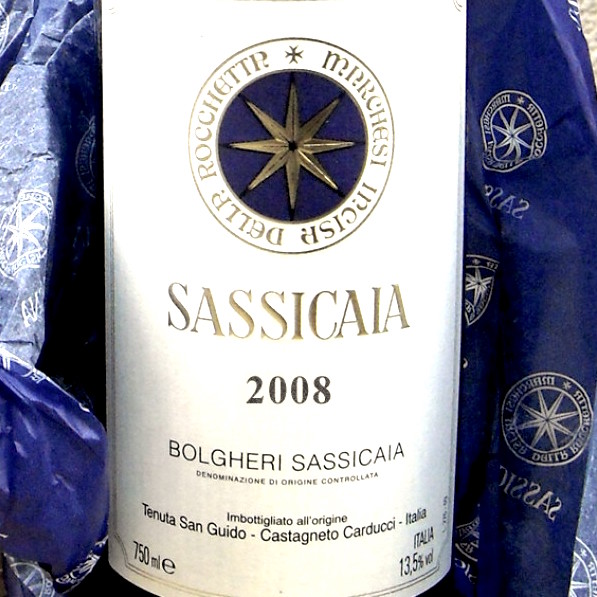 OWNER
OWNER
Tenuta San Guido
APPELLATION
Bolgheri
BLEND
85% Cabernet Sauvignon, 15% Cabernet Franc
AVERAGE SCORE
94/100
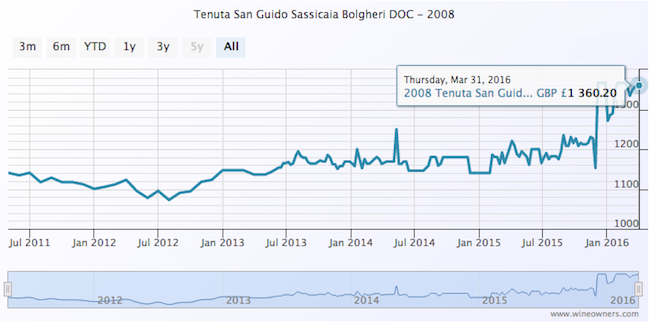
REVIEW
The 2008 Sassicaia is a rich, deep wine imbued with notable class in its black cherries, plums, grilled herbs, minerals and smoke. The 2008 is a decidedly buttoned-up, firm Sassicaia that is currently holding back much of its potential, unlike the 2006 and 2007, both of which were far more obvious wines. Readers who can afford to wait will be treated to a sublime wine once this settles down in bottle. Muscular, firm tannins frame the exquisite finish in this dark, implosive Sassicaia. The 2008 Sassicaia is 85% Cabernet Sauvignon and 15% Cabernet Franc. The wine spent 24 months in French oak barrels. Anticipated maturity: 2018-2038. Tenuta San Guido is on a roll these days. Over the last few years, the estate has released a number of hugely delicious wines. These new releases are nicely aligned with their respective vintages. The entry-level Le Difese and Guidalberto both capture the essence of a sunny year that made wines well suited to near-term drinking, while the 2008 Sassicaia captures the potential of a powerful vintage characterized by low yields and a late harvest. (Robert Parker, 2011).
by Wine Owners
Posted on 2014-05-16
What was truly historic about this tasting was that every wine served was from magnum. Since Monfortino was not bottled in magnums every vintage (Roberto's father shied away from larger formats because they had to be hand-bottled) this tasting was of EVERY Monfortino vintage EVER bottled in mags.
The magnums all came from a collector in Italy, known to Roberto, and acquired by Antonio some time ago. Theoretically, because the wines have been stored in exactly the same conditions since release, what you were therefore tasting is the vintage differences, with the exception of the 1970 which was made from bought-in grapes as was the custom of the time. Cascina Francia was bought by Roberto's father in 1974.
The flights were arranged thematically. This was an inspired choice, with warmer vintages grouped together, cooler shades, modern day classics etc.
The magnums were decanted 4 hours in advance of the start of the dinner.
The wines were poured in advance of each course arriving, so that the wines could be tasted alone and with matched dishes.
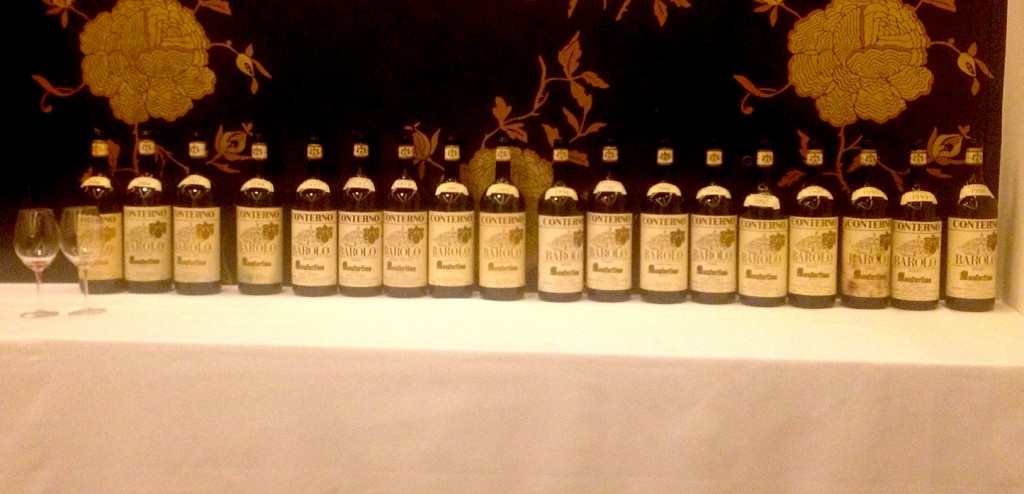
Flight 1: To Start
Served with crispy chicken thighs and charred lettuce.
1988
Ripe, expressive nose, sweet and pronounced pepperiness. Pale brick rim, limpid ruby core. Really thick glycerol. Grippy and bright, with a persistent citric thread. Mouthwatering finish with tertiary leafy notes.
An hour later a bit loose-knit.
1993
Cool nose. Pure creamy fruit, subdued pepper, orange brick rim with a deeply coloured core. Fresh, intense fruit, orange zesty, progressive cedar notes. A little closed on the mid-palate then blooms into a very long finish.
An hour later rich, confit, firm and excellent.
Wine of the flight.
1995
Sweet nose, elegant, fruity and floral. Pale pink rim with orange tinge. Fluid, integrated palate, crystalline and precise.
An hour later, very complete. Grippy, heady fruit, masculine.
Flight 2: The warm vintages
Served with a layered Foie gras terine, pomegranate, sauternes gel.
1990
Warm pepper nose, powerful and spirity. Translucent rim. So young on the palate, with an amazing entry that is grippy with thrilling acidity. So young.
An hour later less grippy but still super-fresh and exciting. Another decade?
1997
Very overt nose; subtle blueberry notes followed by macerated cherries and summer pudding. Blueberries on the entry, texturally dense with a lifted mid-palate, mouthwatering. Vivid fluid palate and finish. Very expressive yet fine.
An hour later, nose has calmed down beautifully, stunningly layered palate with floral notes. Wine of the flight.
1998
Creamy nose, white pepper, liqueur. Pale orange rim, shining ruby core. Warm entry, a little less precision than the preceding wine, softly spiced fruit, confit aftertaste and a vibrant, fabulously driven finish.
2000
Rye bread nose, spirity, herbal and fresh, with pinot-like undertones. Pink-tinged, strawberry-coloured core. Supremely elegant palate, soft yet dry. Aside from the nose, you would never guess this was the product of warm vintage.
Flight 3: cooler shades
Served with beef Fillet Tataki, pickled onion and something called Wakame.
1987
Rich, heady nose, deep colour, pink tinged rim. Energetic and intense, dramatic yet elegant. Floral mid palate, powerfully and progressively builds to an endless finish. Perfect balance.
Wine of the flight (head)
1996
Not a good bottle sadly. Oxidative Bovril nose, fresh and mouthwatering , sherbet finish, short and un-knit. This was the better of the 2 bottles opened apparently, the first being corked (not served).
2002
Sweet, perfectly poised nose of red and soft fruits. Reminiscent of pinot within the strawberry flavor spectrum. Sweet, gentle pastille fruit. Very long. Beautiful and one for burgundy lovers. Adorable.
Wine of the flight (heart)
2005
Macerated fruit nose. Savoury notes with grippy cool tannins then dark brooding fruit with a sour twist to the mid-palate, before pushing on to an enduringly deep but firm finish.
An hour later, perfectly resolved.
Flight 4: the epic vintages
Served with cannon of lamb and lamb belly, cauliflower pureé and lentils - a masterpiece.
1970
Very alluring savoury nose. Surprisingly deep colour. Slightly gamey, intense and powerful, complex and perfectly poised. Flavours contained by the evident structure of the wine. The wine sings properly with the lamb.
Wine of the flight.
1982
Saline nose, faintly oxidative before it blows off then pure sweet fruit. Slightly volatile, very bright sexy fruit, very intense confit character lifted by a powerful freshness.
1995
Darkly fruited nose, very pure. Translucent scarlet colour. Such a lovely balance. Grainy palate. Elegant, deeply veined fruit.
1999
Primary nose of pure fruit, edgeless. Primary colour with the merest hint of a maturing rim. Stuningly defined, intense but balanced fruit. So refreshing. The ultimate food wine and a future monument for 10-20 years hence.
Future icon of the night.
Flight 5: modern day classics
Served with cheese.
2001
White pepper nose, pure and pale rimmed, limpid ruby, pretty medium weight.
2004
Ripe, fleshy and overtly fruity nose. Deep colour, purple-rimmed. Structured, powerful, grainy palate.
2006
Peppery, fruity, fresh cool nose. Classic form. Very pretty ruby colour. Glycerol drenches the side of the glass. Stunningly pure, linear fruit
Wine of the flight.
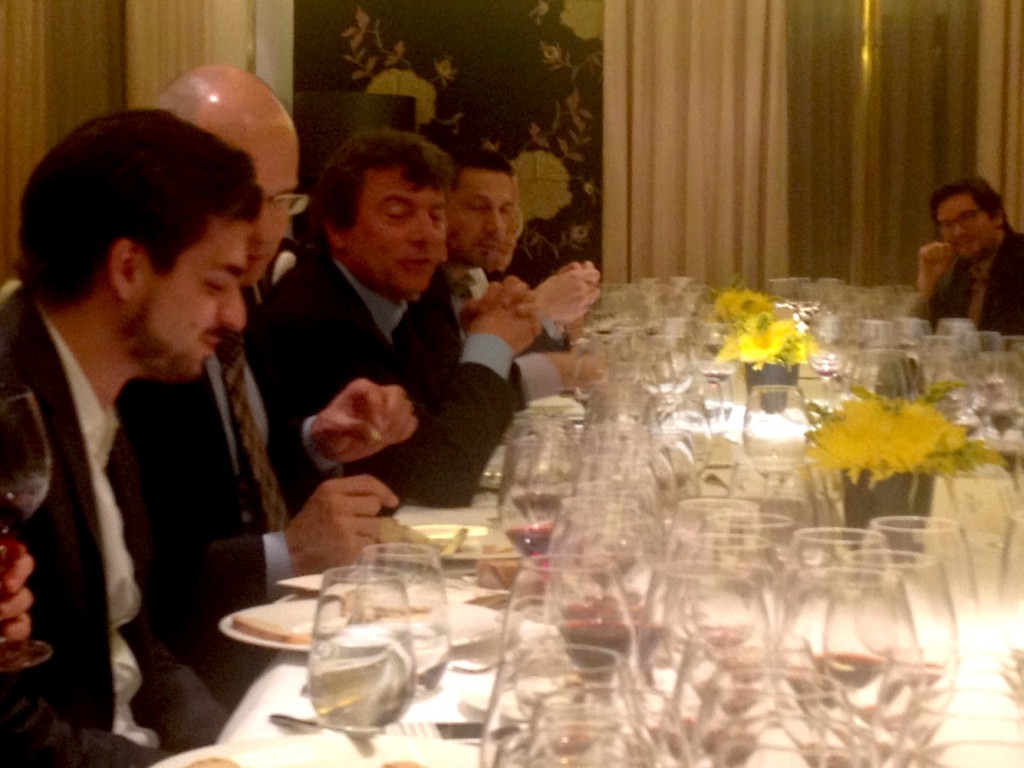
by Wine Owners
Posted on 2014-01-13
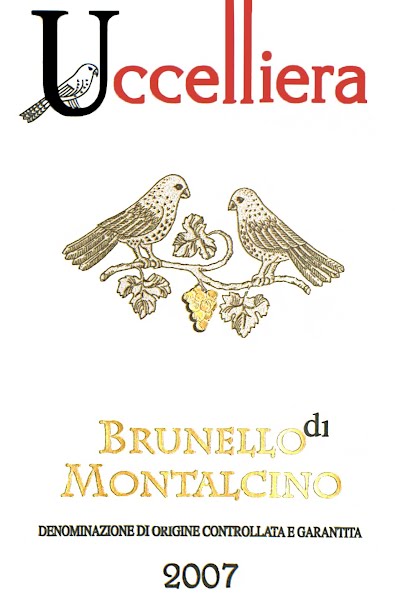
Another good value Italian that has come up for sale recently is the 2007 Brunello from Andrea Cortonesi’s Uccelliera estate. Richer, and more powerful than the wines from Cortonesi’s Voliero estate, Uccelliera is a fine example of a traditionally dramatic and expressive Brunello which in this vintage makes for attractive early drinking. At £155 per 6 on the Exchange, the price is hugely sensible compared to many similar scoring wines. The Brunello from Poggio di Sotto, for example, while likely to be a more long-lived example, commands almost 3 times the price of these bottles, making them look rather compelling.
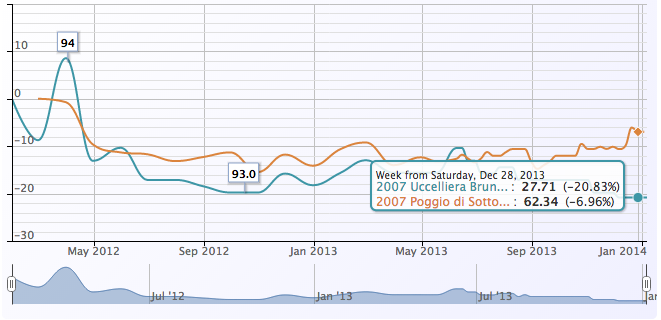
'The 2007 Brunello di Montalcino is lush, sweet and inviting. Today the 2007 doesn’t quite have the sheer visceral thrill and excitement of the 2006, but it more than makes up for that with its early approachability. Dark red berries, spices and crushed flowers are layered into the finish. There is plenty of volume but not a lot of structure. The 2007 Brunello was made from three separate parcels with different altitudes and exposures. Malolactic fermentation was done in steel and the wine was aged in a combination of casks and neutral small French oak barrels. Anticipated maturity: 2015-2025.'
94 Antonio Galloni, Wine Advocate
by Wine Owners
Posted on 2014-01-06
Worthy of attention on the Exchange this week as a value proposition is the 2010 Coparossa Barbaresco from Bruno Rocca, which outperforms the theoretically superior 2007 vintage but still comes in marginally lower priced (the 2007 appears in the UK market at a low of £211). The Coparossa is effectively a ‘vieilles vignes’ cuvee, sourced from older plantings in First floors of Neive and Treiso, so marks a qualititative step up from the straight Barbaresco bottling, from younger vines, but is not a single vineyard cuvee like the Rabaja. Antonio Galloni and Wine Advocate seem to be in accord that the 2010 Coparossa is the best yet made from a producer who seems to be very much on an upward trajectory in terms of quality and reputation.
According to Galloni, it’s clear from what he has tasted that ‘the best wines from this small, family-run domaine have yet to be made, and that is more than enough to be energised about what is happening here.’ With a constant build in quality, and the fact that in many vintages the Coparossa outscores the single vineyard bottling, the 2010 vintage looks like decidedly good value.
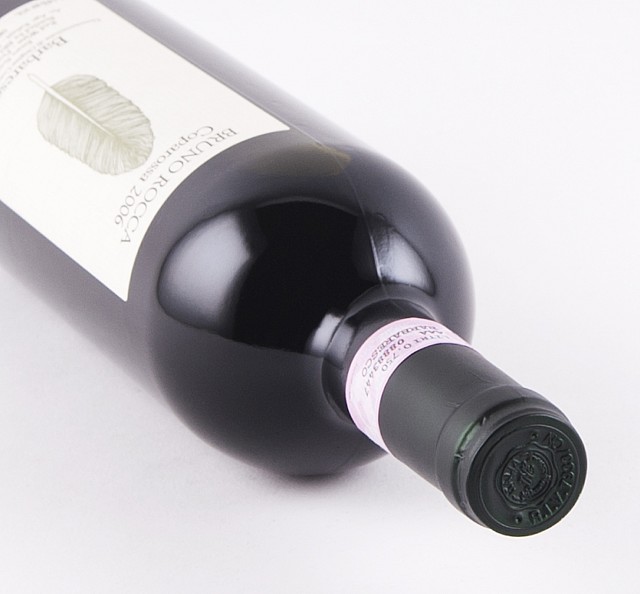
“The 2010 Barbaresco Coparossa brings together the structure of the year with a huge core of fruit, a combination that is hugely appealing. Dark red cherry, plum, cinnamon, licorice and leather all blossom in an expressive, layered wine loaded with personality. With time in the glass, the wine turns explosive. Orange zest, rose petals and cloves linger on the exotic finish. The style is energetic, tense and vibrant.”
95 (1997- 93 pts) Antonio Galloni, Vinous Media
“The 2010 Barbaresco Coparossa is extremely elegant and refined with dried flowers, herbal notes, bright cola and Pinot-like softness. This is a stunning effort. The wine is irresistibly silky and sensuous on the palate, imparting clean fruit flavors that last long on the finish. It delivers fabulous length with seemingly never-ending intensity and persistency.”
Anticipated maturity: 2015-2028.
96 points, Monica Larner, Wine Advocate

